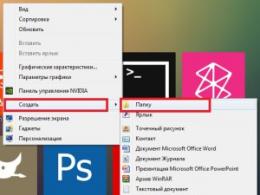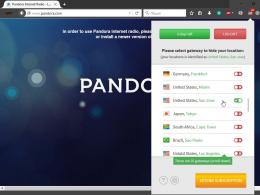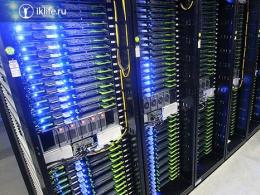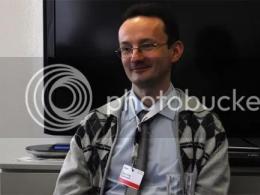What elements are in the windows main menu. How the Main Menu works in Windows XP. What is the Windows context menu and how to call it
24. Main menu in Windows. Main Menu structure and commands, purpose
The Windows main menu opens by clicking the Start button and provides access to all the main tools and applications on your computer. If you install a new program on your computer, its name usually appears in the Main Menu in the “Programs” item, from where this program can be launched. The content and structure of the Main Menu can be adjusted quite widely. Menu and submenu navigation can be accelerated. It is not necessary to go through all menu items using arrows. You can press the hot letter of a menu item. This can be a specially defined hot letter, which is underlined in the name of the menu item. Otherwise, the first letter of the menu item name will be hot if there is no specially defined hot letter. Unfortunately, accelerated search is not always possible for names starting with Russian letters. At a minimum, for this, Russian must be installed on the computer as the default language
25. Control panel in Windows OS. Purpose, composition.
The control panel is a tool for configuring the operating system. It consists of groups of tools divided by purpose.
1.Equipment setup.
2.Configuring the interface.
3.Software setup.
4.Tools embedded in the software equipment production control panel
Administration-group within the control panel provides access to the operating system settings including all other settings groups. You can access the settings using (via) the property command in the context menu of the corresponding system objects. The system folder network environment allows you to configure network equipment. For making settings in the Windows operating system, starting from the NT family, has organizer rights.
26. The concept of a menu, types of menus in Windows, working with menus
Menu-list of commands.
1.Main menu(Start) - there are commands that correspond to certain operations (setup, help). Using the main menu, you can launch all programs installed under the operating system or registered in it, open the latest documents with which you worked, gain access to all tools operating system settings, as well as access to Windows search and help systems.
2.System menu-this menu freely allows you to manage your computer, administrative functions, manage disks (formatting, cleaning, checking), running utility and standard utilities, it allows you to easily navigate local disks, just like this is done from Explorer.
3.Service menu- allows you to control the size and location of the window on the Desktop, called by clicking the cursor on the system icon. 4. Context menu - a set of commands that the OS selects for the user in a given situation for the selected object (called by the right mouse button).
27. Text editors and processors. Purpose and types of text editors.
1st three positions: symbol, words, line. 1st type of text editor programs that allow you to work with text encodings of the ASCII table, 2nd UNICOD. ASCII encoding 1 byte. UNICOD containing 2 bytes.
1. The simplest editor. They can only change text, do not support formats and are based on screen or system fonts.
2. Special text edited for writing programs. The functionality necessary for various programming languages is added.
3.Text editors with text formatting by paragraphs, words and symbols. The document will be perceived as text.
4.Text editors with graphics support (graphic objects are text elements)
5.Documents will be displayed both as I see and as I print WYSYG.
a) separation;
b) graphic objects
c) table.
Its name is word processors.
6.Desktop publishing systems (2000-XP).
28. The concept of an electronic document in Windows OS. Types of electronic documents.
A document file associated with Windows applications.
A Word doc cannot always be a Windows doc, only after saving.
Types of electronic documents: txt, doc, rtf, html.
The main menu provides access to almost all Windows functions and allows you to perform work related to launching programs, obtaining help, searching and opening documents, and configuring the system.
Purpose of Main Menu items:
Documentation
This item displays a list of the last 15 documents the user has recently worked with. In this submenu, if you click on a document or file associated with an application, it will be loaded and the selected file will be open and ready for use.
Settings
Provides quick access to the Toolbar, which allows you to change hardware configurations and user settings. The Settings item also opens access to the Printers folder, and finally, this item allows you to open the Taskbar Properties window.
Search
Allows you to find files and folders on any available disk device on local and external networks. You can search for a file not only by name, but also by creation date, text fragment contained inside, or file type.
Reference
Opens the Windows 98 help system, which contains comprehensive information on all system features and methods of using them.
Execute
Allows you to enter a command line, with which you can execute a DOS command, run an application, or open a folder by entering the full file name.
Shutdown
Allows you to correctly shut down Windows 98. In this case, all open files are first saved or messages are displayed in which the system asks you to do this. Then all temporary files that are not needed for further operation of the system are deleted. When you select Shutdown, you are given the opportunity, instead of turning off the computer, to reboot the system or return back to Windows or DOS.
In the course of describing the Main Menu items, I had to use not yet described concepts, such as the Taskbar, Explorer, My Computer, Recycle Bin, Network Neighborhood, Communications.
The Control Panel provides easy access to the Registry. Registry is a Windows 98 database that stores information about user settings, hardware configuration, installed programs, application and file type correspondence, and other system information. Settings items are accessed through icons in the Control Panel. Double-clicking on the icon provides access to the relevant information for changing or adding to it.
Explorer, My Computer, Network Neighborhood are tools built into Windows 98 designed to work with files. They are used to search for files, folders or networked computers. Explorer is launched from the Programs submenu of the Main Menu.
Basket. This is the place where deleted files are automatically placed. You can optionally either restore them from there or throw them out of the Recycle Bin. This tool protects you from accidentally deleting necessary files.
24. Main menu in Windows. Main Menu structure and commands, purpose
The Windows main menu opens by clicking the Start button and provides access to all the main tools and applications on your computer. If you install a new program on your computer, its name usually appears in the Main Menu in the “Programs” item, from where this program can be launched. The content and structure of the Main Menu can be adjusted quite widely. Menu and submenu navigation can be accelerated. It is not necessary to go through all menu items using arrows. You can press the hot letter of a menu item. This can be a specially defined hot letter, which is underlined in the name of the menu item. Otherwise, the first letter of the menu item name will be hot if there is no specially defined hot letter. Unfortunately, accelerated search is not always possible for names starting with Russian letters. At a minimum, for this, Russian must be installed on the computer as the default language
25. Control panel in Windows OS. Purpose, composition.
The control panel is a tool for configuring the operating system. It consists of groups of tools divided by purpose.
1.Equipment setup.
2.Configuring the interface.
3.Software setup.
4.Tools embedded in the software equipment production control panel
Administration-group within the control panel provides access to the operating system settings including all other settings groups. You can access the settings using (via) the property command in the context menu of the corresponding system objects. The system folder network environment allows you to configure network equipment. For making settings in the Windows operating system, starting from the NT family, has organizer rights.
26. The concept of a menu, types of menus in Windows, working with menus
Menu-list of commands.
1.Main menu(Start) - there are commands that correspond to certain operations (setup, help). Using the main menu, you can launch all programs installed under the operating system or registered in it, open the latest documents with which you worked, gain access to all tools operating system settings, as well as access to Windows search and help systems.
2.System menu-this menu freely allows you to manage your computer, administrative functions, manage disks (formatting, cleaning, checking), running utility and standard utilities, it allows you to easily navigate local disks, just like this is done from Explorer.
3.Service menu- allows you to control the size and location of the window on the Desktop, called by clicking the cursor on the system icon. 4. Context menu - a set of commands that the OS selects for the user in a given situation for the selected object (called by the right mouse button).
27. Text editors and processors. Purpose and types of text editors.
1st three positions: symbol, words, line. 1st type of text editor programs that allow you to work with text encodings of the ASCII table, 2nd UNICOD. ASCII encoding 1 byte. UNICOD containing 2 bytes.
1. The simplest editor. They can only change text, do not support formats and are based on screen or system fonts.
2. Special text edited for writing programs. The functionality necessary for various programming languages is added.
3.Text editors with text formatting by paragraphs, words and symbols. The document will be perceived as text.
4.Text editors with graphics support (graphic objects are text elements)
5.Documents will be displayed both as I see and as I print WYSYG.
a) separation;
b) graphic objects
c) table.
Its name is word processors.
6.Desktop publishing systems (2000-XP).
28. The concept of an electronic document in Windows OS. Types of electronic documents.
A document file associated with Windows applications.
A Word doc cannot always be a Windows doc, only after saving.
Types of electronic documents: txt, doc, rtf, html.
Menu Windows
The Windows operating system uses several types of menus.
1. Main menu (Start button menu) is shown in Fig. 1. It is called up by clicking on the “Start” button and its appearance depends on the user’s settings. Its options:
§ Shutdown – shutdown, restart the computer, log in with a different password
§ Execute – you can load a program for execution that is not in the “Programs” menu
§ Help and support – you can get help on the Windows system
§ Find – allows you to find information on a given computer or on the Internet
§ Settings – allows you to change the parameters of devices connected to this computer
§ Documentation – opens a list of the last 15 documents opened on this computer using this password
§ Programs – opens a list of programs that are installed on this computer for download.
The rest of the menu options are self-explanatory.
2.
 System menu
(call – click on the window icon in the title line (the left picture in the blue line of the window)). Allows you to manage Windows windows using the keyboard (if the buttons in the upper right corner of the window (the “Minimize”, “Maximize”, “Close” buttons) are not visible). Can be used if the mouse does not work for some reason.
System menu
(call – click on the window icon in the title line (the left picture in the blue line of the window)). Allows you to manage Windows windows using the keyboard (if the buttons in the upper right corner of the window (the “Minimize”, “Maximize”, “Close” buttons) are not visible). Can be used if the mouse does not work for some reason.
3.
 Command menu
applications (menu bar in all application windows). The number and content of command menu options varies from program to program. For example, in the word processor program Word these are the options “file”, “edit”, “view”, “insert”, “format”, “service”, “table”, “window”, “help”.
Command menu
applications (menu bar in all application windows). The number and content of command menu options varies from program to program. For example, in the word processor program Word these are the options “file”, “edit”, “view”, “insert”, “format”, “service”, “table”, “window”, “help”.

4. Object command menu (file_edit_view_?). Shown in Figure 4 for the My Computer window
5.
 Pictographic menu
. You can also find other names: tool menu, tool menu. The tool menu essentially duplicates the command menu, but unlike it, it provides direct access to the corresponding option. When using the command menu, you would have to make several clicks to get to the desired option.
Pictographic menu
. You can also find other names: tool menu, tool menu. The tool menu essentially duplicates the command menu, but unlike it, it provides direct access to the corresponding option. When using the command menu, you would have to make several clicks to get to the desired option.

 6.Context menu
(Fig. 6.) is always called by right-clicking the mouse. For each object, the context menu has a different appearance, which is why it is also called context-sensitive. This type of menu is probably the most used. Almost all operations on objects can be done using the context menu.
6.Context menu
(Fig. 6.) is always called by right-clicking the mouse. For each object, the context menu has a different appearance, which is why it is also called context-sensitive. This type of menu is probably the most used. Almost all operations on objects can be done using the context menu.
7.Popup (swing) menu (Fig. 7). Called by clicking on the corresponding icon. The selection of sub-options is carried out similarly to other types of menu.

Menu(English) menu, fr. menu) is a user interface element that allows you to select one of several listed program options. In modern operating systems, the menu is the most important element of the graphical user interface.
Menu items can be selected by the user using any of the pointing input devices provided by the electronic device.
Menu types
The following menu types are distinguished:
- · according to execution:
- · text
- · graphic;
- by function:
- · main menu of the application;
- · pop-up menu;
- · context menu;
- · system menu.
Menu items
menu item -- individual application options.
pictogram illustrating an action
separator (visually separates groups of similar menu items)
“stop” limits the movement of the cursor
Menu items are usually grouped into:
Menu bar(English) menu bar) - the main part of the menu, which is constantly located in the application window (less often, it hides and appears during certain user actions). This line is the so-called main menu of the window. main menu) or top-level menu (English) top-level menu), which may contain
Pop-up menu(English) popup menu) or submenu(English) submenu). Selecting a main menu item usually calls up a submenu that appears below the main menu, which in turn may contain submenus.
Thus, the menu forms a hierarchical structure of the application's functionality.
Menu items in the main and pop-up menus can be enabled. enabled), turned off (English) disabled) or unavailable (eng. grayed). Sometimes, instead of the words “on” and “off,” the words “active” and “inactive” are used. Typically, items marked as enabled or disabled look the same to the user, and an unavailable menu item appears somewhat darkened, in particular gray.
Pop-up menu items can be marked. checked), while to identify that an item is selected, either special marks are used (see checkbox) (for example, in Microsoft Windows and GNOME the “tick” icon is used - ?), or by changing the color scheme of any element of the menu item ( mainly used for non-standard graphical menus).
How Menu Items Work
All or part of the menu elements can work as a real menu, i.e. as a group of independent counting buttons (counting triggers, T-triggers) from which, as in a real menu, you can select one, two or more items, but more often there are groups of dependent buttons that work as a multiphase trigger, i.e. from a group of items you can select only one item, after selecting which the previously selected item is reset, but this is no longer a menu, but a switch.
Menu in the command line interface
In a command line interface, a menu is implemented by listing options and prompting you to enter a symbol (word, number...) indicating the desired option. For example:
- 1) U-turn
- 2) Left
- 3) Straight
- 4) Right
Your choice (1234) ?_
This menu is controlled by simply entering the desired value from the list. Sometimes you need to press Enter to enter; otherwise - only a “hot key”, or enter a certain number of characters. If you press Enter without entering a specific value, the default action may be performed (in the example given, “Spread”).
Menus driven by pointing devices
In more advanced interfaces, selecting a menu item can be done by “pointing” to its image on the screen.
Although such menus can also be controlled by hotkeys (specialized or poorly made interfaces may not have hotkeys), it is possible to select between menu items using the arrow keys or a pointing input device. Pointing device-driven menus are used in televisions, mobile phones, and other devices with pointing input devices
The complexity of selecting an item from the menu
To reduce the complexity of selecting an item from a menu using a pointing input device, the selected menu item must differ significantly in color, texture and other characteristics from the background and have the largest possible size (area). Menus with a “stop” allow you to blindly move the cursor to the stop and select the desired menu item by pressing the button. The turbo menu does not allow you to do this without a “stop”.





